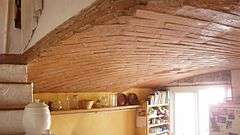Catalan vault

The Catalan vault (Catalan: volta catalana), also called tile vault, Catalan turn, Catalan arch or timbrel vault, is a type of low arch made of plain bricks often used to make a structural floor surface. It is traditionally constructed by laying bricks lengthwise over a wood form or "centering", making it a much gentler curve than has generally been produced by other methods of construction.
Of Roman origin,[1] it is a traditional form in Catalonia (where it is widely used), and has spread around the world through the work of Catalan architects such as Antoni Gaudí and Josep Puig i Cadafalch, and the Valencian architect Rafael Guastavino.
A study on the stability of the Catalan vault is kept at the archive of the Institute of Catalan Studies, where it is said to have been entrusted by Josep Puig i Cadafalch.
Though it is popularly called the Catalan vault, this construction method is found throughout the Mediterranean and the invention of the term "Catalan vault" occurred in 1904 at an architectural congress in Madrid. The earliest known written reference to this vault is from Valencia in 1382, although there were used before in Catalonia, Valencia and Majorca.
See also
External links
- Ramage, Michael. "Construction of a Vault". details the process of constructing a six-foot by six-foot vault.
References
- ↑ Detail, issue no.: 05/2013 Technology: The Catalan Vault. Accessed 14-Oct-2015
| Wikimedia Commons has media related to Volta Catalana. |